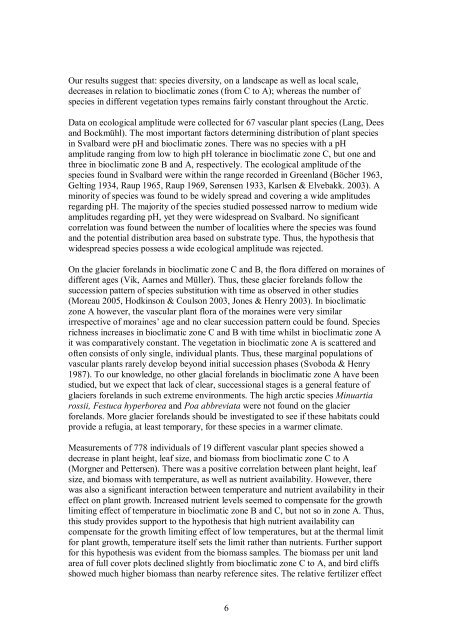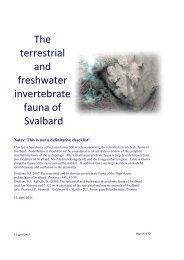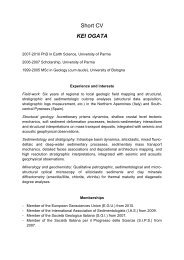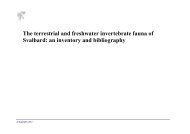Arctic plant ecology: From tundra to polar desert in Svalbard - Unis
Arctic plant ecology: From tundra to polar desert in Svalbard - Unis
Arctic plant ecology: From tundra to polar desert in Svalbard - Unis
Create successful ePaper yourself
Turn your PDF publications into a flip-book with our unique Google optimized e-Paper software.
Our results suggest that: species diversity, on a landscape as well as local scale,<br />
decreases <strong>in</strong> relation <strong>to</strong> bioclimatic zones (from C <strong>to</strong> A); whereas the number of<br />
species <strong>in</strong> different vegetation types rema<strong>in</strong>s fairly constant throughout the <strong>Arctic</strong>.<br />
Data on ecological amplitude were collected for 67 vascular <strong>plant</strong> species (Lang, Dees<br />
and Bockmühl). The most important fac<strong>to</strong>rs determ<strong>in</strong><strong>in</strong>g distribution of <strong>plant</strong> species<br />
<strong>in</strong> <strong>Svalbard</strong> were pH and bioclimatic zones. There was no species with a pH<br />
amplitude rang<strong>in</strong>g from low <strong>to</strong> high pH <strong>to</strong>lerance <strong>in</strong> bioclimatic zone C, but one and<br />
three <strong>in</strong> bioclimatic zone B and A, respectively. The ecological amplitude of the<br />
species found <strong>in</strong> <strong>Svalbard</strong> were with<strong>in</strong> the range recorded <strong>in</strong> Greenland (Böcher 1963,<br />
Gelt<strong>in</strong>g 1934, Raup 1965, Raup 1969, Sørensen 1933, Karlsen & Elvebakk. 2003). A<br />
m<strong>in</strong>ority of species was found <strong>to</strong> be widely spread and cover<strong>in</strong>g a wide amplitudes<br />
regard<strong>in</strong>g pH. The majority of the species studied possessed narrow <strong>to</strong> medium wide<br />
amplitudes regard<strong>in</strong>g pH, yet they were widespread on <strong>Svalbard</strong>. No significant<br />
correlation was found between the number of localities where the species was found<br />
and the potential distribution area based on substrate type. Thus, the hypothesis that<br />
widespread species possess a wide ecological amplitude was rejected.<br />
On the glacier forelands <strong>in</strong> bioclimatic zone C and B, the flora differed on mora<strong>in</strong>es of<br />
different ages (Vik, Aarnes and Müller). Thus, these glacier forelands follow the<br />
succession pattern of species substitution with time as observed <strong>in</strong> other studies<br />
(Moreau 2005, Hodk<strong>in</strong>son & Coulson 2003, Jones & Henry 2003). In bioclimatic<br />
zone A however, the vascular <strong>plant</strong> flora of the mora<strong>in</strong>es were very similar<br />
irrespective of mora<strong>in</strong>es’ age and no clear succession pattern could be found. Species<br />
richness <strong>in</strong>creases <strong>in</strong> bioclimatic zone C and B with time whilst <strong>in</strong> bioclimatic zone A<br />
it was comparatively constant. The vegetation <strong>in</strong> bioclimatic zone A is scattered and<br />
often consists of only s<strong>in</strong>gle, <strong>in</strong>dividual <strong>plant</strong>s. Thus, these marg<strong>in</strong>al populations of<br />
vascular <strong>plant</strong>s rarely develop beyond <strong>in</strong>itial succession phases (Svoboda & Henry<br />
1987). To our knowledge, no other glacial forelands <strong>in</strong> bioclimatic zone A have been<br />
studied, but we expect that lack of clear, successional stages is a general feature of<br />
glaciers forelands <strong>in</strong> such extreme environments. The high arctic species M<strong>in</strong>uartia<br />
rossii, Festuca hyperborea and Poa abbreviata were not found on the glacier<br />
forelands. More glacier forelands should be <strong>in</strong>vestigated <strong>to</strong> see if these habitats could<br />
provide a refugia, at least temporary, for these species <strong>in</strong> a warmer climate.<br />
Measurements of 778 <strong>in</strong>dividuals of 19 different vascular <strong>plant</strong> species showed a<br />
decrease <strong>in</strong> <strong>plant</strong> height, leaf size, and biomass from bioclimatic zone C <strong>to</strong> A<br />
(Morgner and Pettersen). There was a positive correlation between <strong>plant</strong> height, leaf<br />
size, and biomass with temperature, as well as nutrient availability. However, there<br />
was also a significant <strong>in</strong>teraction between temperature and nutrient availability <strong>in</strong> their<br />
effect on <strong>plant</strong> growth. Increased nutrient levels seemed <strong>to</strong> compensate for the growth<br />
limit<strong>in</strong>g effect of temperature <strong>in</strong> bioclimatic zone B and C, but not so <strong>in</strong> zone A. Thus,<br />
this study provides support <strong>to</strong> the hypothesis that high nutrient availability can<br />
compensate for the growth limit<strong>in</strong>g effect of low temperatures, but at the thermal limit<br />
for <strong>plant</strong> growth, temperature itself sets the limit rather than nutrients. Further support<br />
for this hypothesis was evident from the biomass samples. The biomass per unit land<br />
area of full cover plots decl<strong>in</strong>ed slightly from bioclimatic zone C <strong>to</strong> A, and bird cliffs<br />
showed much higher biomass than nearby reference sites. The relative fertilizer effect<br />
6








